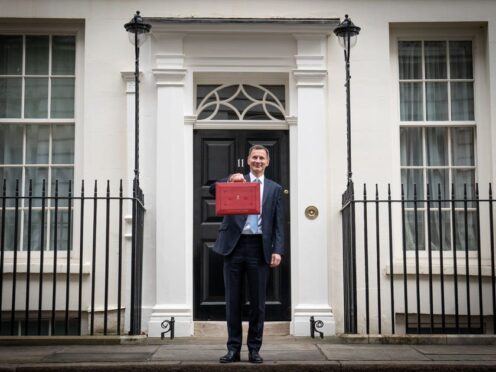Jeremy Hunt will use his Budget to offer a pre-election tax giveaway for millions of workers.
But how big will the tax cut be and what are the choices he will have to make to fund it?
Here are some of the key questions he faces:
– What will be his flagship policy?
The Chancellor and Prime Minister Rishi Sunak have consistently hinted at tax cuts, and with an election looming and the Conservatives a long way behind in the polls, they will be keen to offer voters as big an incentive as possible to stick with the Tories.
Reducing the basic rate of income tax by a penny would cost about £7.3 billion while a cheaper option would be a 1p reduction in the main rates of national insurance contributions paid by employees and the self-employed, at around £5 billion a year.
But there is speculation that Mr Hunt could gamble and go for an even more eye-catching cut – knocking 2p off national insurance or income tax.
– How can he afford that?
The Chancellor is bound by his self-imposed fiscal rules, which include having national debt as a share of gross domestic product (GDP) falling by the end of a five-year period. The gap between his tax and spending plans and the limits set by this rule is known as the headroom.

As well as potentially eating into this headroom – leaving less of a buffer to cope with unexpected events – Mr Hunt is likely to tinker with a few taxes to raise some extra cash. The non-dom tax status for wealthy overseas individuals could be changed or scrapped and a levy on vapes could also help fill the Treasury coffers.
But the big prize for Mr Hunt would be economic growth – as well as generating extra tax income, an increase in GDP changes the balance when it comes to calculating the headroom available for meeting his fiscal rule.
– Is that realistic?
The economy entered a technical recession at the end of 2023, with two successive quarters of falling output.
But most economists expect the picture to improve with a return to GDP growth – albeit at low levels – and inflation likely to continue to fall.
GDP is estimated to have fallen in October to December (Quarter 4):
▪️ services fell (-0.2%)▪️ construction fell (-1.3%)▪️ production fell (-1.0%)
➡️ https://t.co/gsheUbREuI pic.twitter.com/r7xi4Eokhu
— Office for National Statistics (ONS) (@ONS) February 15, 2024
Much will depend on the Office for Budget Responsibility’s forecasts for the economy in determining how much leeway the Chancellor has to spend his way out of the Conservatives’ political troubles.
– What else is likely to be in the Budget?
A £360 million investment in advanced manufacturing projects across the life sciences, automotive and aerospace sectors is set to feature in the Budget as well as a package of £800 million intended to boost public sector productivity.
Mr Hunt has also announced changes to pension regulations, including a requirement for funds to declare how much they invest in UK companies, in order to “focus minds” and boost investment in British businesses.
And fuel duty is likely to remain at its current rate, keeping the “temporary” 5p cut which has been in place since 2022.
– So with a general election this year, where does that leave Labour?
The Opposition is prepared for the Tories to operate a “scorched earth” policy, using up any funds available to woo voters with tax cuts while leaving public spending facing a painful, and possibly implausible, spending squeeze after the election.
Choosing to adopt Labour policies such as scrapping the non-dom status – which Sir Keir Starmer’s party had hoped to use to fund services such as the NHS – and instead putting the money towards tax cuts will leave Rachel Reeves facing the prospect of either reversing Mr Hunt’s giveaways or putting up other taxes to deliver on spending pledges if she becomes chancellor.
